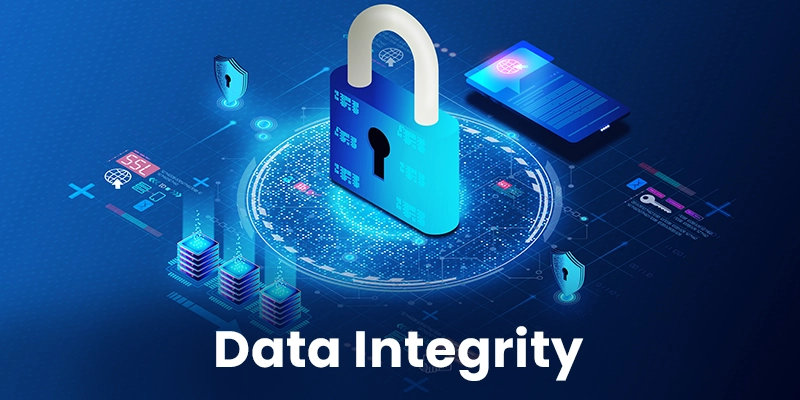
Data Integrity: Why is It Important in 2025?
Maintaining data integrity ensures that data is trustworthy and reliable, free from errors, and has not been tampered with or compromised in any way. Errors or inaccuracies can lead to poor decision-making and lower business performance, so this is crucial for organizations that use data to make decisions.
Note: In 2016, Wells Fargo was found to have opened millions of unauthorized bank accounts in their customers’ names in an attempt to meet sales targets. The fallout was catastrophic, resulting in multi-billion dollar fines, legal settlements, and irreparable damage to the bank’s reputation.
The above story serves as the perfect example for understanding the imminent need to ensure data integrity. It is increasingly critical for organizations to adopt practices that preserve the integrity of their data.
This article will provide insights into how data validation, access controls, and regular data backups can help ensure data integrity.
What is Data Integrity?
Data Integrity is maintenance, assurance, accuracy and consistency of data over its entire life-cycle.
Integrity testing data plays a crucial role in maintaining data integrity, including assessments designed to evaluate the consistency, accuracy, and reliability of data within a system or database.
It focuses on maintaining the 3Cs i.e. Correctness, Completeness, and Consistency of data from creation to deletion. It guarantees that the information you receive is correct and accurate, without any alterations or compromises.
To avoid errors, organizations that use data for decision-making, operations, and performance must verify their data.
In the following sections we shall discuss the various nuances associated with data integrity.
Types of Data Integrity
There are two types of Data Integrity, physical and logical integrity, which work together to safeguard data against various threats and ensure the reliability and trustworthiness of the information stored in a database. Let’s have a look at them:
1. Physical integrity
Physical integrity protects data during storage, maintenance, and retrieval from natural disasters, power outages, and disk drive failures. Due to human error, storage erosion, and other issues, data processing managers, system programmers, applications programmers, and internal auditors may not get accurate data.
2. Logical integrity
Logical integrity maintains data in relational databases. Unlike physical integrity, logical integrity safeguards information from accidental disclosure and malicious intrusion from hackers and human error. There are four kinds of logical integrity:
-
Entity integrity
Entity integrity uses primary keys to ensure the unique identification of data, prevent duplicates, and avoid null values, facilitating efficient data storage and utilization in relational database systems.
-
Referential integrity
Referential integrity controls appropriate changes, additions, and deletions, prevents duplicates, and ensures accurate and relevant data entry by using rules embedded in the database’s structure, specifically with foreign keys.
-
Domain integrity
Domain integrity is the process that ensures data accuracy in a domain. In this context, a domain is a column’s valid value. Constraints and other measures can limit data format, type, and amount.
-
User-defined integrity
User-defined integrity involves rules and constraints that fit the user’s needs. Sometimes more than an entity, referential, and domain integrity is needed. It measure should consider business rules.
Why is Data Integrity Important?
Data integrity is data’s reliability throughout its lifecycle. Transfers, storage, backup, archiving, and destruction are included. It requires validation that it has not been corrupted or compromised by human error or malicious actions.
As data volumes increase exponentially, ensuring their accuracy becomes more crucial than ever. Data integration and interpretation are important as they help in the following:
- Making accurate predictions and effective business decision making
- Ensuring compliance requirements to avoid legal issues or penalties
- Maintaining accurate and reliable data pool
- Helps control data access
- Prevent unauthorized access, modification, or destruction of data.
- Ensuring successful data recovery from backups
- Protects user privacy
- Reducing errors and rework
- Data changes must be tracked and the user responsible for them identified.
- Mitigating potential data security risks
The Three Pillars of Data Integrity:

These “Three Pillars of Data Integrity” act as a framework that outlines the fundamental principles necessary to maintain the accuracy and reliability of data. Let’s take a deeper dive into this topic:
| Pillar | Interpretation |
| Accuracy | Data must be recorded correctly and completely, without any intentional or unintentional errors. |
| Completeness | Data must include all the necessary information, and no relevant information should be excluded. |
| Consistency | Data must be uniform and consistent throughout its lifecycle, and any changes or updates should be properly documented and tracked. |
Is Your Data at Risk?
As the volume of data continues to grow exponentially, so do the risks to its integrity. From cyber attacks to human errors, there are many threats that can compromise the accuracy and reliability of your data.
Let’s discuss them:
1. Human Error
It may occur due to a lack of proper training, carelessness, or misunderstanding of the data entry process. For instance, a data entry operator may enter incorrect information, misspell a name, or enter data in the wrong field.
2. System Malfunctions
System malfunctions are another common threat to data integrity. This happens due to hardware failures, software bugs, or system crashes. Data corruption and loss compromise integrity.
3. Unauthorized Access
Unauthorized access refers to when a person or system gains access to data or information without proper permission or authorization. This type of access can lead to compromised data integrity because the unauthorized party may manipulate, destroy, or steal the data.
4. Insufficient Validation and Testing
This occurs when data is entered into a system without being verified. Insufficient validation and testing can lead to a variety of data integrity issues, such as incorrect data being entered into the system, data being lost or corrupted during transmission, or data being altered by unauthorized users.
5. Poor Data Governance
Poor data governance refers to the lack of policies, processes, and procedures for managing data throughout its lifecycle. This can include inadequate data classification, unclear ownership, inconsistent data standards, and insufficient data quality controls.
How to Ensure Data Integrity for Your Business?

It is like a seatbelt for your business – it may not seem important until disaster strikes. By ensuring data integrity, you’re buckling up for a bumpy ride and making sure your business stays safe on the data highway.
Ensuring data integrity requires a comprehensive approach that involves the implementation of various technical , procedural measures and requires a proactive and ongoing approach.
Some key steps to ensure data integrity include:
1. Implementing Access Controls
This practice involves limiting who has access to certain data or systems to maintain the accuracy and reliability of the data.
By restricting access to data, organizations can prevent unauthorized users from accessing sensitive information or making unauthorized changes to data.
2. Regularly Backing Up Data
Backups are essential for ensuring the integrity of data in case of data loss or corruption due to hardware failure, natural disasters, cyber-attacks, or other unforeseen events.
By backing up data on a regular basis, organizations can ensure that they have access to a recent copy of their data, even in the event of a catastrophic failure or attack.
3. Implementing Data Validation Procedures
Ensuring that data entered into systems is accurate and meets specified requirements.
4. Conducting Regular Audits
Regularly reviewing data systems and procedures to identify any potential vulnerabilities or areas for improvement.
5. Providing Employee Training
Educating employees on data integrity best practices and policies to prevent human errors that can compromise data integrity.
6. Implementing Security Measures
Implementing technical security measures such as encryption, firewalls, and intrusion detection systems to protect against cyber threats.
By implementing these measures and regularly reviewing and updating them, organizations can ensure the integrity of their data and protect it from threats.
How to Check Data Integrity in a Database?
Checking data integrity helps to detect any potential errors, inconsistencies or discrepancies in the data. The following practices help in seamlessly performing database checks:
1. Referential Integrity
Referential integrity checks ensure the consistency and accuracy of relationships between tables in a database. This type of check is particularly important in relational databases, where multiple tables are linked together through foreign keys.
2. Unique Constraint
This practice ensures the values in a column or set of columns are unique across all rows in the table. This helps to maintain data integrity by ensuring that each row in the table is unique and that there are no duplicate values in the column.
3. Data Type
Data type checks verify the data type of a database column. For instance, an integer column must contain integers, not text or other data types. If the data type is wrong, calculations, sorting, and searching can fail. Database management systems and database-interacting programming languages can perform data type checks.
4. Range
Checks verify column values. Range checks can ensure that ages in a column are between 0 and 120, a reasonable range for humans. Outside this range, data integrity is compromised and must be fixed.
5. Nullability
Nullability checks ensure non-presence of nulls in mandatory data fields. Null values can corrupt data. Database administrators can check nullability by constraining columns or tables to non-null values.
6. Check Constraint
Before allowing data into the database, constraint checks verify that it meets the criteria. Gatekeepers, these checks accept only data within a range, format, or condition. Databases can avoid chaos and inconsistencies by using check constraints.
This involves ensuring that all data in the database meets the constraints defined by check constraints.
Tools for Maintaining Data Integrity

The tools mentioned below can help organizations ensure data is accurate, reliable, and secure. Let’s have a look at them:
1. Encryption
Encryption programs are an essential component of maintaining data integrity and security. These tools are designed to encrypt data, making it unreadable to anyone without the appropriate encryption key.
2. Data Validation
These programs can check data for errors and inconsistencies and flag them so they can be fixed. They can also change and validate data in complicated ways.
3. Database Auditing
These software programs monitor or keep track of who made changes to a database and when those changes were made. This can help find any changes made without permission and keep the data’s integrity.
4. Data Profiling
Data profiling programs analyze and understand the structure, quality, and content of their data. These tools examine data sources to identify patterns, relationships, and anomalies, and generate statistical summaries and reports.
5. Backup and Recovery
Data recovery and backup tools help organizations backup and recover data in the event of a data loss or corruption.
Data Integrity Trends for 2025
Increased Focus on Data Privacy
Organizations must prioritize data privacy measures, including robust data integrity practices to protect sensitive data and maintain customer trust.
Emphasis on Regulatory Compliance
GDPR and CCPA compliance will continue to drive strong data integrity measures to ensure data accuracy, security, and lawful use.
Rise in Data Governance and Stewardship
2024 will see more and more Organizations increasingly adopt formal data governance frameworks and appoint data stewards to manage, document, and protect data throughout its lifecycle.
Integration of AI and Machine Learning
AI(Artificial Intelligence) and ML(Machine Learning) will automate data validation, anomaly detection, and predictive analytics to help identify and resolve data quality issues, ensuring data integrity.
Growing Importance of Data Quality Management
Maintaining data requires data quality management practices like data cleansing and enrichment.
Continuous Monitoring and Auditing
2024 will also see companies monitor and audit in real-time to prevent data integrity issues and keep data accurate, consistent, and up-to-date.
Conclusion
Data integrity is critical for organizations that rely on data for decision-making and business performance. Maintaining data integrity ensures that data is trustworthy and reliable, free from errors, and has not been tampered with or compromised in any way.
The key principles of data integrity include accuracy, completeness, consistency, timeliness, security, traceability, and compliance. It is important for organizations to adopt practices that preserve the integrity of their data, such as data validation, access controls, and regular data backups.
FAQs
What are the 4 types of data integrity?
The 4 types of data integrity are mentioned below:
- Entity integrity
- Referential integrity
- Domain integrity
- User-defined integrity
What is good data integrity?
Good data integrity refers to data accuracy, completeness, and consistency throughout its entire life cycle.
What are the three attributes of data integrity?
The three attributes of data integrity are:
- Accuracy
- Completeness
- Consistency
How do you determine data integrity?
It can be determined through various methods such as data validation, profiling, cleansing, and audits.
What are the three data integrity controls?
- The three data integrity controls are:
- Input controls
- Processing controls
- Output controls
What is a Data Integrity Plan?
A Data Integrity Plan is a documented strategy that outlines the processes and procedures that an organization will use to maintain its data’s accuracy, completeness, and consistency.
Is data integrity good or bad?
It is good because it ensures that data is reliable and trustworthy, which is essential for making informed decisions.
What is a data integrity policy?
Data integrity policies help in governing data accuracy, consistency, and reliability throughout its lifecycle. The policy usually covers data validation, access control, backup and recovery, and retention.
 written by
written byAbout Author






